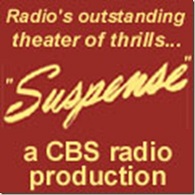
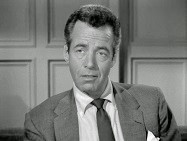 Suspense (1942-1962) aired “Short Order” on August 18, 1945 as the 154th of its 945 episodes. I’d like to thank Asimov’s author and Old Time Radio enthusiast Pete Wood for suggesting it.
Suspense (1942-1962) aired “Short Order” on August 18, 1945 as the 154th of its 945 episodes. I’d like to thank Asimov’s author and Old Time Radio enthusiast Pete Wood for suggesting it.
As recounted in the introduction to the more than 50 episodes of Suspense we’ve shared over the past eleven years, it was one of the most well produced, written, acted, and critically acclaimed of all radio shows during the Golden Age of Radio, many a film star jumping at the chance to perform in an episode, among them Cary Grant, Orson Welles, Jimmy Stewart, Susan Hayward, Vincent Price, Charles Laughton, Loretta Young, Peter Lorre, and Rita Hayworth. After many another radio show had gasped its last breath during the 1950s, Suspense finally closed shop in September of 1962 whereupon radio historians proclaimed the Golden Age of Radio dead, television having become the medium of choice in America.
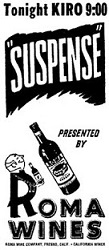 As for “Short Order,” it begins benignly enough, unveiling its dark menace in a slow, calculated manner. The scene is a small diner, a hamburger and coffee joint, run by its owner and the young lad newly hired as cook. The diner barely gets by and, though certain items are in short supply due to war shortages and such basic condiments as ketchup are difficult to acquire, he manages to hang on. Then one day an unknown man enters the diner and soon becomes a regular. The catch is that his face is so disfigured and ugly he soon drives out all of the diner’s customers, forcing an awkward confrontation with the owner lest he lose his diner completely for lack of business. What the result of this confrontation is becomes the heart and soul of the show and is something that cannot be revealed here. What can be revealed is the actor playing the part of the disfigured customer, for it is none other than ubiquitous character actor Gerald Mohr (1914-1968, photo top right). According to Mohr’s wikipedia page and other sources, he “appeared in more than 500 radio plays, 73 films, and over 100 television shows.” Mohr’s face was one of the most recognizable in all of television, though if you grew up watching the shows in which he played a part you probably never took the time to learn his name, just knew him by sight as a familiar face, sometimes a good guy and sometimes a bad guy. Just a few of the programs in which he played supporting roles were Maverick, Cheyenne, Bonanza, The Rifleman, Wanted: Dead or Alive, Perry Mason, I Love Lucy, an appearance as guest on The Smothers Brothers Show, and as the narrator of the opening lines of the first 16 shows of the first season of The Lone Ranger.
As for “Short Order,” it begins benignly enough, unveiling its dark menace in a slow, calculated manner. The scene is a small diner, a hamburger and coffee joint, run by its owner and the young lad newly hired as cook. The diner barely gets by and, though certain items are in short supply due to war shortages and such basic condiments as ketchup are difficult to acquire, he manages to hang on. Then one day an unknown man enters the diner and soon becomes a regular. The catch is that his face is so disfigured and ugly he soon drives out all of the diner’s customers, forcing an awkward confrontation with the owner lest he lose his diner completely for lack of business. What the result of this confrontation is becomes the heart and soul of the show and is something that cannot be revealed here. What can be revealed is the actor playing the part of the disfigured customer, for it is none other than ubiquitous character actor Gerald Mohr (1914-1968, photo top right). According to Mohr’s wikipedia page and other sources, he “appeared in more than 500 radio plays, 73 films, and over 100 television shows.” Mohr’s face was one of the most recognizable in all of television, though if you grew up watching the shows in which he played a part you probably never took the time to learn his name, just knew him by sight as a familiar face, sometimes a good guy and sometimes a bad guy. Just a few of the programs in which he played supporting roles were Maverick, Cheyenne, Bonanza, The Rifleman, Wanted: Dead or Alive, Perry Mason, I Love Lucy, an appearance as guest on The Smothers Brothers Show, and as the narrator of the opening lines of the first 16 shows of the first season of The Lone Ranger.
For long time fans of Old Time Radio, Mohr had a long history, spanning the decades of the early 1930s through the 1950s (when radio could see its best days in the rear view mirror and TV was on the rise). He is probably best remembered for starring as Raymond Chandler’s most famous hardboiled detective in Philip Marlowe (1948-51). A few other shows in which he appeared or starred include The New Adventures of Nero Wolfe as Archie Goodwin, The Whistler, The Shadow of Fu Manchu, Box 13, and Escape. It was a small surprise to learn he played this particular role in this episode of Suspense, but he played it to the hilt, helping to make “Short Order” an eminently memorable episode.
Play Time: 29:26
{The neighborhood gang was in hog heaven the evening this episode of Suspense aired, the gang riding the wave of exultation and relief flowing from their parents at the recent end of World War II in the Pacific, following the second atomic bomb dropped on the city of Nagasaki on August 9, 1945, and Emperor Hirohito’s official surrender on the 15th. Pockets jingled with nickels and dimes due to the largesse of happy parents as the gang made their way to the nearby newsstand for an unexpected opportunity to enlarge their pulp collections. Having already bought their usual must-have SF magazines, they turned to their next favorite genre, that of the crime/detective variety. Dime Detective (1931-53) was one of the longest running detective pulps among dozens on the shelves from which to choose, testament to its ability to satisfy readers over the long haul. It was a monthly in 1945. New Detective (1941-53) entered the fray a decade after Dime Detective and promised a different type of story, though over time it continued to rely on a more or less familiar (but competently wrought) type of police/crime fare. It proved popular with its fans for well over a decade, halting its presses the same year as Dime Detective due to the pulp magazine purge of the early 1950s when many pulps failed to survive. It was a bi-monthly in 1945. The Shadow (1931-49) was an easy choice. Over its almost several decades in print, a comic strip (1940-42), a comic book (1940-49), 6 short films and 3 hour long films (from 1931-1940 as of this radio episode in August of 1945), and on radio (1937-54) it had become an iconic presence in the minds of young and old alike. It was a monthly in 1945.}
[Left: Dime Detective, Aug. 1945 – Center: New Detective, July 1945 – Right: The Shadow, Aug. 1945]
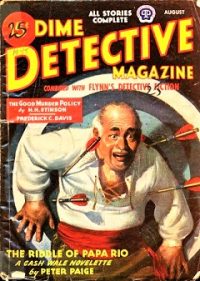
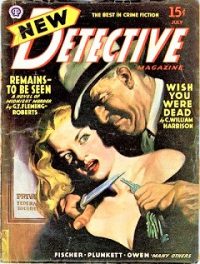
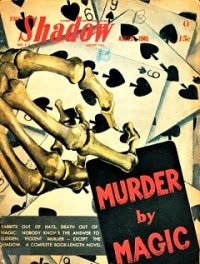
To view the entire list of weekly Old Time Radio episodes at Tangent Online, click here.